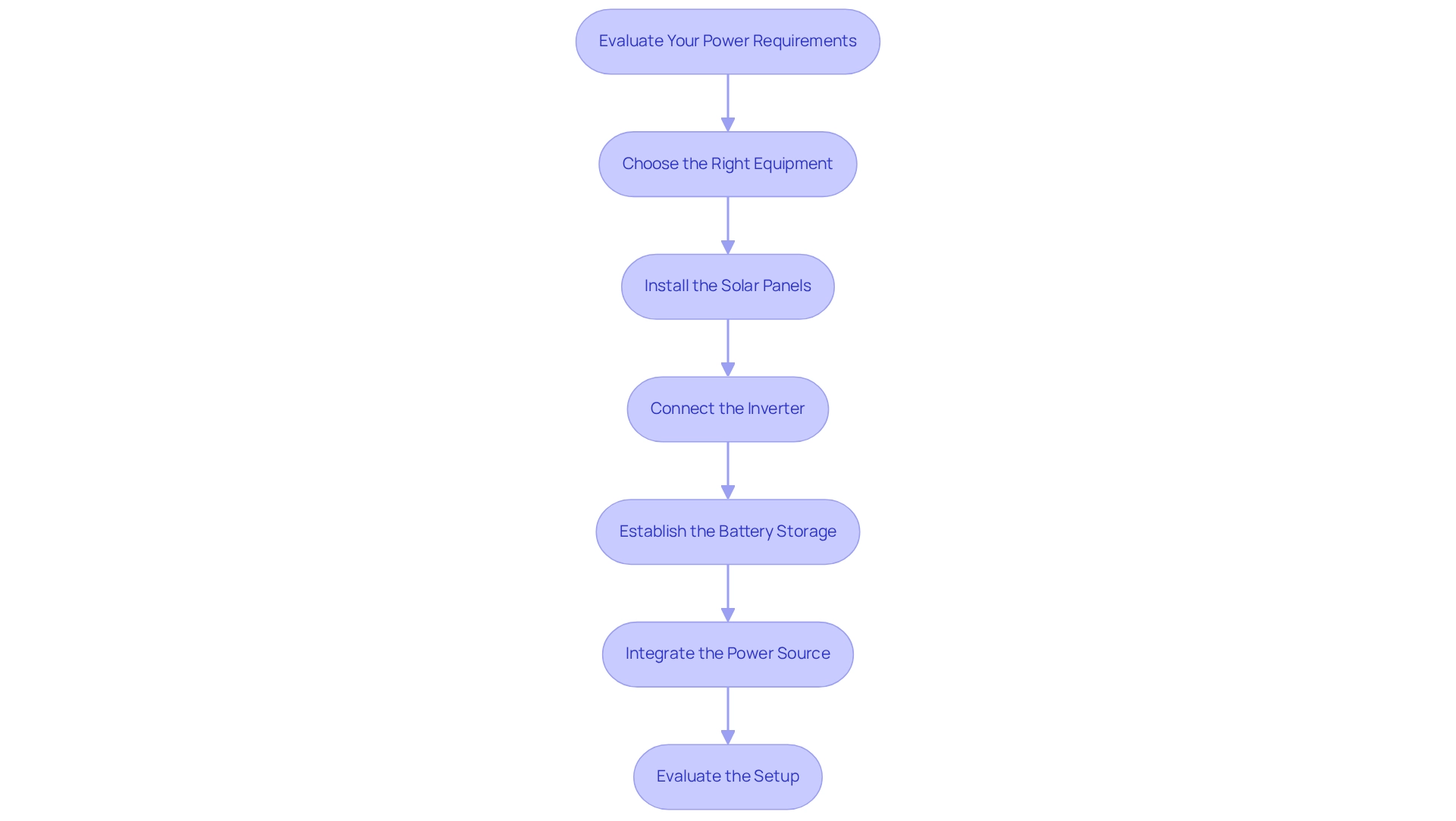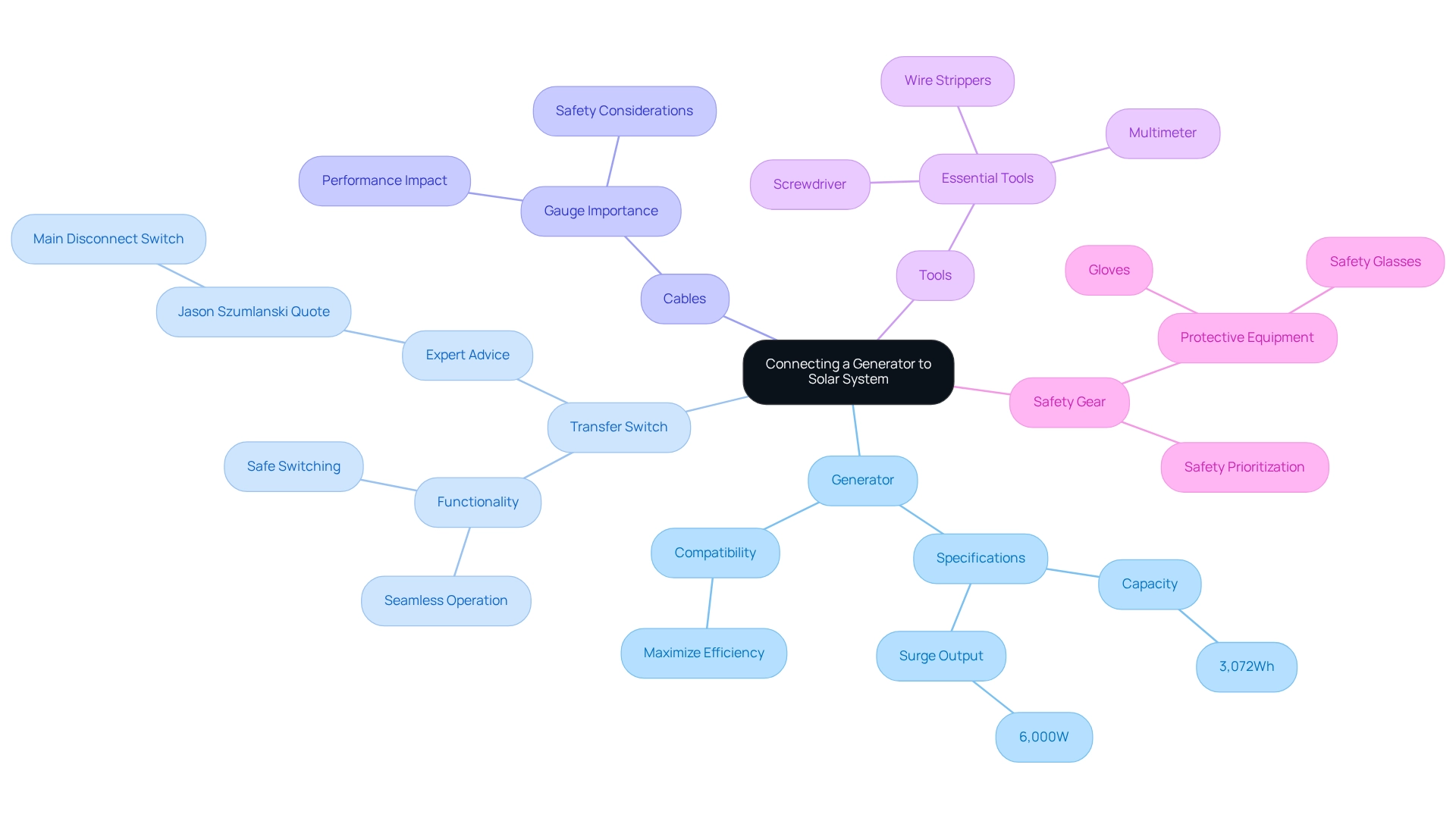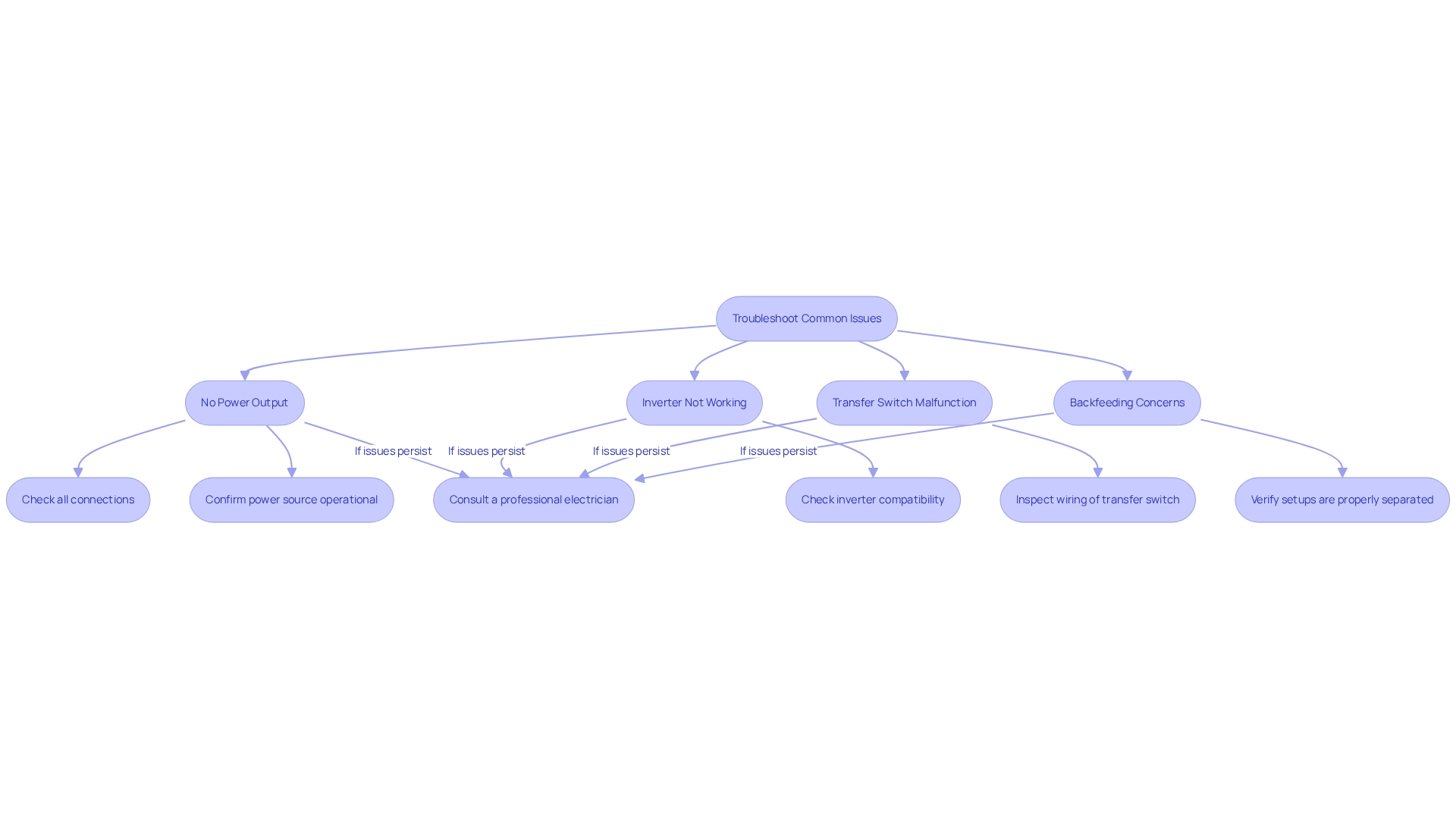Overview
As homeowners, it’s natural to worry about rising energy bills and the impact on your budget. To connect a generator to a solar system, we encourage you to follow a step-by-step guide that begins with:
- Evaluating your power needs.
- Selecting the appropriate equipment.
- Integrating a transfer switch securely to ensure seamless operation.
Understanding the mechanics of solar systems is vital, as it not only enhances safety but also boosts efficiency during the installation process. Remember, using the right tools can make all the difference. Together, we can navigate this journey towards energy independence, ensuring that you feel supported every step of the way.
Introduction
As energy bills continue to rise, many homeowners are understandably concerned about their energy independence. With the increasing demand for sustainable energy solutions, turning to solar systems and generators offers a promising path forward. Understanding the intricacies of these systems is essential for effective integration and a reliable power supply. It’s common to feel overwhelmed by the options available, but as solar technology evolves, harnessing sunlight through photovoltaic panels and utilizing generators for backup power becomes not just a possibility, but a vital skill for enhancing your energy independence.
This article delves into the essential components, installation steps, and troubleshooting tips for connecting solar systems with generators. By exploring these key elements, we can work together to ensure that you maximize efficiency and minimize disruptions in your power supply. We understand that navigating this journey can be daunting, but with the right guidance and support, you can confidently take steps toward a more sustainable energy future. Let’s embark on this journey together, empowering you to make informed decisions that benefit both your home and the environment.
Understand the Basics of Solar Systems and Generators
Understanding the Fundamentals of Solar Panels and Power Sources
We understand that many homeowners are concerned about rising energy bills and the impact of energy dependence on their lives. Before establishing any connections, it’s crucial to comprehend the mechanics of solar setups and power sources. Solar arrays harness sunlight through photovoltaic (PV) panels, converting it into electricity, while generators serve as backup power sources, transforming fuel into electricity when necessary. To combine these networks safely, it’s essential to ensure they function independently to prevent backfeeding, which can harm equipment. Key components for safe connections include inverters, which convert DC electricity from photovoltaic panels to AC electricity, charge controllers that manage battery charging, and transfer switches that allow seamless switching between power sources.
Recent statistics reveal a significant trend in adoption, with a reported 76% growth in installations in 2023 and projections of 33% growth for 2024. This increase indicates a rising number of homeowners in California embracing renewable energy solutions alongside backup power sources for improved energy autonomy and dependability. The expense of PV installation varies from $5,400 to $18,000, providing significant context for homeowners contemplating how to connect a generator to a solar system in conjunction with these systems. Significantly, around 90% to 97% of photovoltaic materials are recyclable, aiding sustainability initiatives. Understanding battery capacity and power ratings is also essential for effective resource management. Power storage capacity, measured in kilowatt-hours (kWh), indicates how much electricity a battery can hold, while power ratings, expressed in kilowatts (kW), determine how much electricity can be utilized at once. To ensure reliable power during high demand periods and adverse weather conditions, homeowners should align the storage unit’s capacity with their electricity requirements.
Step-by-Step Guide to Installing Solar Systems
- Evaluate Your Power Requirements: Calculate your household’s power usage to establish the suitable size of your photovoltaic system.
- Choose the Right Equipment: , inverters, and batteries that satisfy your power requirements and budget.
- Install the Solar Panels: Mount the panels on your roof or in a suitable location, ensuring they receive maximum sunlight exposure.
- Connect the Inverter: Install the inverter to convert DC electricity from the panels to AC electricity for your home.
- Establish the Battery Storage: Link the battery storage setup to retain surplus power produced by the photovoltaic panels.
- Integrate the Power Source: If utilizing a power source, link it to your renewable energy setup using a transfer switch to guarantee uninterrupted power supply during outages, which is essential when learning how to connect a generator to a solar system.
- Evaluate the Setup: Once everything is connected, assess the installation to ensure it functions correctly and efficiently.
By understanding these networks and their components, California homeowners can effectively harness clean energy while ensuring reliable power during outages, addressing their key concerns of energy independence and cost savings. Together, we can work towards a more sustainable future.
Gather Necessary Tools and Materials for Connection
Connecting a generator to a solar system can feel daunting, but with the right tools and materials, you can ensure a smooth and efficient setup. Here’s what you’ll need to get started:
- Generator: It’s important to ensure compatibility with your solar system to maximize efficiency. For instance, the AC300 US New BLUETTI AC300 + 1*B300 Home Battery Backup boasts a capacity of 3,072Wh and a surge output of 6,000W, making it a .
- Transfer Switch: This essential device is important for learning [how to connect a generator to a solar system](https://floridasolardesigngroup.com/install-generator-existing-solar-panels), allowing for safe switching between solar and backup power and ensuring seamless operation. As Jason Szumlanski wisely advises, “If you don’t like supply side interconnections, simply install a main disconnect switch on the line side of the transfer switch.”
- Cables: Choosing cables of the appropriate gauge is crucial for understanding how to connect a generator to a solar system, as this significantly impacts both performance and safety.
- Tools: Essential tools include a screwdriver, wire strippers, and a multimeter for testing connections and ensuring everything is functioning correctly.
- Safety Gear: Prioritizing safety is paramount. Always wear gloves and safety glasses when working with electrical components to protect against potential hazards.
Moreover, understanding optimal battery options is vital for effective power storage and enhancing your system’s performance. Selecting the right battery type, whether lithium-ion or lead-acid, can lead to substantial financial benefits and improve your power independence. By preparing these items, you’ll simplify the installation process and make it easier to harness renewable energy effectively while ensuring your safety and reliability. Together, we can work towards a sustainable future that empowers you with energy independence.
Follow Step-by-Step Instructions to Connect the Generator
- Turn Off All Power Sources: Before you begin the installation, it’s essential to ensure that both your photovoltaic setup and backup power unit are completely shut down. This precaution helps to prevent any risk of electrical shock, allowing you to proceed with peace of mind.
- Install the Transfer Switch: Position the transfer switch close to your main electrical panel. Following the manufacturer’s guidelines for proper wiring is crucial for ensuring safety and functionality.
- To understand how to connect a generator to a solar system, use the correct cables to link the output of your power source to the transfer switch. It’s important to confirm that all connections are tight and secure, as this will help prevent any electrical issues down the line.
- To learn how to connect a generator to a solar system, link the solar setup by attaching the solar inverter to the transfer switch. Make sure that the solar installation remains isolated from the power source during this process.
- Test the System: Once all connections have been made, power on both the power source and the transfer switch. Utilize a multimeter to verify that electricity is flowing correctly to your home, ensuring everything is functioning as it should.
- Monitor Performance: During the initial usage phase, closely observe your setup to ensure it operates smoothly and safely. If you notice any irregularities, address them promptly.
- Routine Upkeep: To guarantee sustained efficiency and dependability, arrange for routine maintenance inspections of both the energy setup and power source. This includes inspecting connections, cleaning components, and testing battery performance.
- Battery Options: Consider incorporating high-quality solar-powered batteries that complement your setup. Options like lithium-ion batteries not only provide effective power storage but also offer extended lifespans, enhancing your overall power management.
As the number of homes equipped with photovoltaic panels continues to grow, it becomes increasingly important to ensure the safe and efficient integration of photovoltaic and backup solutions. Understanding how photovoltaic panels operate and selecting the right battery options for power storage can significantly enhance your setup’s efficiency. Moreover, illustrates the successful implementation of renewable energy, highlighting the benefits of connecting producers to photovoltaic setups. Together, we can navigate this journey towards energy independence, ensuring a brighter and more sustainable future for all.
Troubleshoot Common Issues During Connection
When linking your power source to a photovoltaic setup, it’s common to encounter challenges that can feel overwhelming. Here are some supportive troubleshooting tips to help you navigate these issues:
- No Power Output: First, we understand that it’s crucial to check all connections to ensure they are secure. Confirm that your power source is operational and has sufficient fuel. Did you know that to reach 6,700 GW of total installed capacity by 2030, annual photovoltaic capacity additions need to increase significantly? This highlights the importance of having . Many homeowners face power output problems, often due to loose connections or equipment failures. Together, we can address these concerns, and Powercore Electric provides extensive photovoltaic panel solutions to help alleviate such issues.
- Inverter Not Working: It’s essential to ensure that your inverter is compatible with your power source and that it is properly connected. Have you checked for any error codes displayed on the inverter? These can provide valuable clues to the problem. Powercore Electric is here to assist you in choosing the appropriate inverter for your energy system, ensuring peace of mind.
- Transfer Switch Malfunction: If your transfer switch isn’t engaging, it’s important to inspect the wiring and confirm that it is installed correctly. A faulty transfer switch can interrupt the flow of electricity between your power source and the photovoltaic setup. Engaging with Powercore Electric can guarantee correct installation and operation, allowing you to feel secure in your energy choices.
- Backfeeding Concerns: If photovoltaic energy is backfeeding into your power source, it’s vital to verify that the setups are properly separated. This can prevent potential damage to both systems, ensuring your investment is protected.
For persistent issues, we encourage you to consult a professional electrician. Their expertise can help recognize and address intricate problems, including how to connect a generator to a solar system, ensuring that your renewable energy setups operate smoothly together. Furthermore, the Inflation Reduction Act has generated interest in photovoltaic installations, emphasizing the need for reliable systems and thorough service to prevent common issues. Powercore Electric is here to provide the support you need for , because together, we can achieve energy independence.
Conclusion
We understand that rising energy bills can be a significant concern for many homeowners. Harnessing the power of solar systems and generators offers a meaningful solution to enhance energy independence and reduce reliance on traditional power sources. By grasping the fundamentals of these systems—such as their components, installation processes, and troubleshooting techniques—you can confidently embark on your journey toward sustainable energy solutions. Integrating solar panels with backup generators not only ensures a reliable power supply but also aligns with the growing demand for renewable energy, contributing to broader sustainability efforts.
The article provided a step-by-step approach to effectively connect solar systems with generators, highlighting the importance of safety and proper equipment. From assessing your energy needs to selecting quality tools and materials, each phase is crucial for achieving an efficient and effective energy setup. It’s common to encounter challenges during installation, which is why addressing potential issues and maintaining vigilance is essential for ensuring that your systems operate smoothly and safely over time.
Ultimately, embracing solar energy and generator integration is a proactive step towards a more sustainable and self-sufficient future. As technology advances and the landscape of energy consumption evolves, we believe that homeowners equipped with the right knowledge and resources can take control of their energy needs. Together, we can contribute to personal savings and a healthier planet. The journey towards energy independence is not merely an option; it is an essential commitment to a sustainable lifestyle that benefits individuals and communities alike. Let’s work towards this brighter future together.





